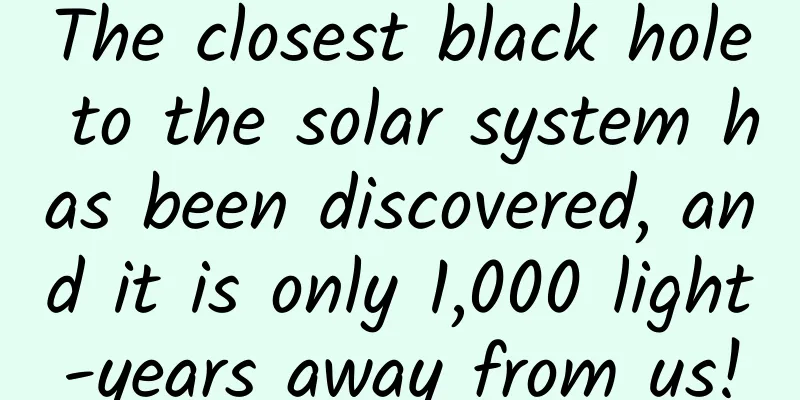The closest black hole to the solar system has been discovered, and it is only 1,000 light-years away from us!

|
[Mobile software: Bo Ke Yuan] A team of astronomers from the European Southern Observatory (ESO) and other institutions has discovered a black hole only 1,000 light-years from Earth. This black hole is closer to the solar system than any other black hole discovered so far, that is, the closest black hole to us so far, and this black hole forms part of a triple star system visible to the naked eye. The research team found evidence of the invisible object by tracking the two companion stars of this black hole using the MPG/ESO 2.2-meter telescope at the La Silla Observatory of the European Southern Observatory in Chile. But this triple system may be just the tip of the iceberg, as more similar black holes may be discovered in the future. "We were completely surprised when we realized that this is the first system where both the black hole and the star can be seen with the naked eye," said Petr Hadrava, scientist emeritus at the Academy of Sciences of the Czech Republic in Prague and co-author of the study. The system is located in the constellation Telescopium and is so close to us, only 1,000 light-years away, that the two companion stars of the black hole can be observed from the Southern Hemisphere on a dark, clear night without the need for a telescope such as binoculars. "This triple black hole system contains the closest known black hole to Earth," said Thomas Rivinius, a scientist at the European Southern Observatory who led the study, whose findings are published in the journal Astronomy & Astrophysics. The team initially observed the system, called HR6819, as part of a study of binary star systems. However, when analysing the observations, the researchers were surprised when a previously undiscovered third object was discovered in HR6819: it was a black hole. The observations, made with the Fellowes spectrograph on the MPG/ESO 2.2-metre telescope at La Silla, showed: One of the two visible stars orbits an invisible object every 40 days, while the second star is very far away from the inner pair. "The observations needed to determine the 40-day period had to be spread out over several months," said Dietrich Baade, co-author of the study and emeritus astronomer at the European Southern Observatory in Garching. This was made possible thanks to ESO's pioneering Service Observing programme, under which ESO staff carry out observations on behalf of scientists who need them. The black hole hidden in HR 6819 is one of the first stellar-mass black holes ever discovered. These black holes do not interact violently with their environment, and therefore appear to be truly "black". But the team was able to discover the existence of this black hole by studying the orbits of the stars within it, and calculate its mass: it is a black hole with a mass at least four times that of the Sun. So far, astronomers have only discovered a few dozen black holes in our galaxy, and almost all of them interact strongly with their environment and indicate their presence by releasing powerful X-rays in this interaction. But scientists estimate that over the lifetime of the Milky Way, many more stars collapsed into black holes as they ended their lives. The discovery of a "silent," invisible black hole in HR6819 provides clues to where many of the Milky Way's hidden black holes might be. There must be a lot of black holes out there, but we know very few. Knowing what to look for should put us in a better position to find them. The discovery of a black hole in a triple system so close to us suggests that we're only seeing the "tip of an exciting iceberg." Astronomers believe the discovery could shed some light on a second system. "We realized that another system, called LB-1, could also be such a triple system, although more observations are needed to be sure of this," said Marianne Heida, a co-author of the study and a postdoctoral researcher at the European Southern Observatory. "LB-1 is a little further away from Earth, but still fairly close in astronomical terms, so this means there could be more of these systems out there. By finding and studying them, we can learn a lot about the formation and evolution of these rare stars, which have masses of about eight times that of our sun and end up leaving behind a black hole in a supernova explosion." These systems, with an inner pair and a distant triple star, are discoveries that could also provide clues to violent cosmic mergers that release gravitational waves powerful enough to be detected on Earth. Some astronomers think mergers can occur in systems similar to HR6819 or LB-1, but where the inner pair consists of two black holes or a black hole and a neutron star. The distant outer object could gravitationally punch the inner pair in a way that triggers a merger and releases gravitational waves. While HR6819 and LB-1 only have a black hole and no neutron stars, these systems could help scientists understand how stellar collisions occur in triple star systems. |
Recommend
Joint flexibility and strengthening
Joint Mobility and Strengthening Resource Introdu...
There was a tornado last night, and the trees were uprooted! How to escape in a tornado?
According to the official Weibo of Guangdong Prov...
The bidding promotion account has poor results and it crashed in less than 2 hours. What should I do?
I wonder if you are in the same situation as me. ...
Kuaishou brand self-broadcast transaction formula
It is no longer a new thing for brands to sell pr...
Why are your efforts worthless?
[[156440]] I asked a graduate student to collect ...
Is the protagonist of the Year of the Rabbit the same rabbit as Spicy Rabbit Head?
The Year of the Rabbit is approaching, and rabbit...
My hairline is gradually moving back. Am I facing a "hair loss crisis"?
Hair loss has always been a headache for young an...
Detailed explanation of four loading methods of Android
[[125130]] In multi-Activity development, there m...
Zhang Ziyi and Wang Feng end their eight-year marriage. Does the "seven-year itch" really exist?
Wang Feng and Zhang Ziyi officially announced the...
Information flow promotion, what are the advantages and effects of Douyin advertising?
Tik Tok is the most popular trendy short video so...
How many layers does the sky have?
Please turn your phone over Today’s “journey to h...
Teacher Wen's Reading Comprehension Class on Douyin
Resource introduction of Teacher Wen's "...
Beichen Asia Market: Analysis of Beijing Automobile Market in May 2024
New car transactions In May, Beijing's new ca...
Zihao, Zixuan, Zirui... The "Zi" that parents like to name their children turns out to be the King of Wood!
Recently, the Public Security Bureau of Foshan Ci...
BYD has fired the first shot in the fight for equal rights for smart driving, with all employees equipped with Dipilot’s Eye of God as standard. Who’s panicking?
There is no doubt that 2025 will be another year ...
![[Original Artifact] Automatically edit short videos with one click, and generate 100 original videos in one second (software + video)](/upload/images/67cbfd3c31d05.webp)








